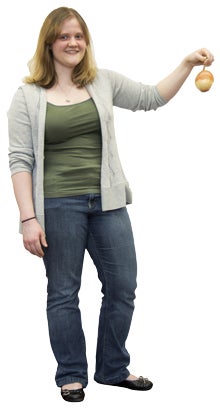A Closer Look at Carbs
It’s a complex world of sugars and starches. URI is using research on students to help us all navigate a path to health.
by Christopher Barrett ’08 M.P.A.’14
Many people count calories in search of better health. The University of Rhode Island’s Kathleen Melanson and her students count carbohydrates—specific kinds of them.

The nutrition and food sciences associate professor and her students are studying how many carbohydrates college students eat. By also asking about health status, the study promises to unearth relationships between the intake levels of specific carbohydrates and the risk of obesity, diabetes, hypertension and cardiovascular diseases.
“It’s a very novel area,” Melanson says. “We’re breaking into new research here because most of the previous research has been done in animals.”
The study focuses on carbohydrate subtypes that behave differently in the body. Most people are familiar with the three main types: sugars, starches and fiber. But in reality, there are hundreds more formed by different combinations of carbon, hydrogen and oxygen. Some lead to health benefits, others health issues.
To study all this, graduate nutrition students Eric Nelson and Brittany Navrkal are administrating a 297-item questionnaire to some 400 URI nutrition students. The survey asks detailed questions about what students eat and how often they eat it. The two, from New Jersey and Nebraska respectively, started administering the questionnaire in fall 2013.
Australian researchers developed the questionnaire as a tool for doctors during patient evaluations. Melanson saw it as a way to identify the amount and specific types of carbohydrates students consume. Most students probably cannot report how much fermentable carbohydrates they ate. But they can report if they ate beans, brown rice or bananas—all of which contain fermentable carbohydrates.
Nelson and Navrkal pore over the results seeking to quantify consumption of specific carbs. No one—to the best of their knowledge—has ever sought to analyze carbohydrate intake by specific type in such a large population. The largest study on fermentable carbohydrates involved fewer than 100 participants, Navrkal says.

Armed with the first batch of results, Nelson and Navrkal are looking for possible connections between carbohydrate consumption and disease risks. Preliminary analysis found interesting information, chiefly that URI college students consume a lot of sugar: about 32 teaspoons a day. The American Heart Association recommends six teaspoons per day for women and nine teaspoons per day for men.

Both presented individually at the Experimental Biology conference in Boston in March. The conference, which drew some 14,000 scientists, selects only a fraction of requests to speak. Organizers also picked Nelson to participate in the Emerging Leaders in Nutrition Research competition, along with fellow URI nutrition student Michael MacArthur of New Hampshire.
Nelson says the true reward was the chance to tell researchers about his work.
“A lot of the major causes of death are related to nutrition,” he says.
While it could take some time for the URI data to work through the medical field, the results already went to the nutrition students who completed the questionnaire. Nelson and Navrkal shared individualized results with each respondent, providing a tailored analysis of nutrition intake.
“The exciting thing for the students is they get feedback from the questionnaire,” Navrkal says. “Not only can they relate the results to what they learned in class, but they can use it to improve their diet.”
Students—and the public—may find carbs in surprising places. Nelson and a team of undergraduate students went through two supermarket aisles and scoured the websites of national restaurant chains. They found sugars hiding in breads, yogurt, salad dressings and condiments.
And Nelson himself knows that reducing sugar intake can lead to a healthier life. He lowered his sugar intake, improved the types of carbs he ate and, along with exercise, lost more than 100 pounds.
The URI team wants to build on the survey results to create intervention tools for medical professionals. Those tools may come in the form of guidelines for limiting intake of specific types of carbs while promoting others. Or they might provide information for food scientists developing healthier products. These tools could also support public health policies such as requiring food labels to list carbohydrates by subtype rather than lumped together.
“Carbohydrates are such a complex body of molecules that do different things,” Melanson says. “You can’t just say carbohydrate and mean one thing.” •
 Home
Home Browse
Browse Close
Close Events
Events Maps
Maps Email
Email Brightspace
Brightspace eCampus
eCampus



